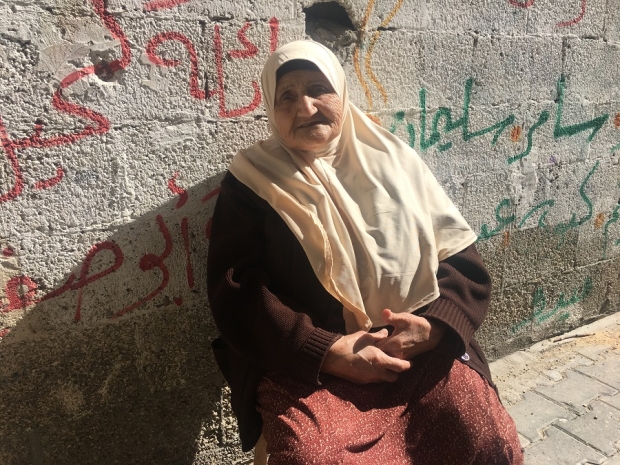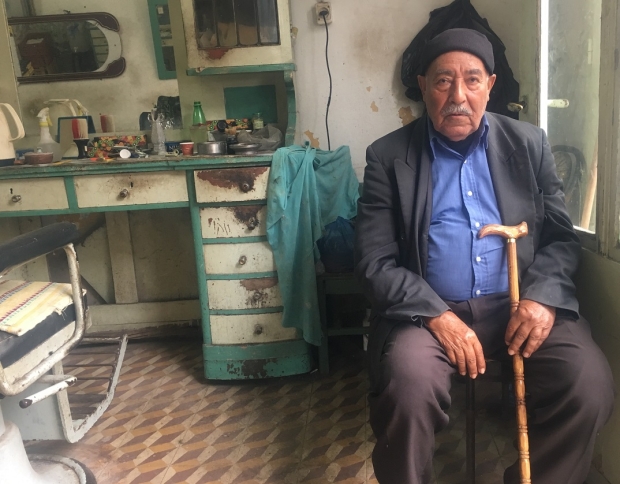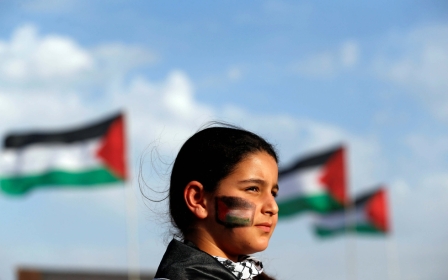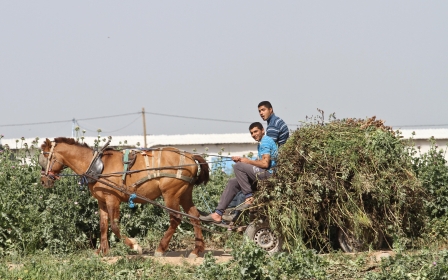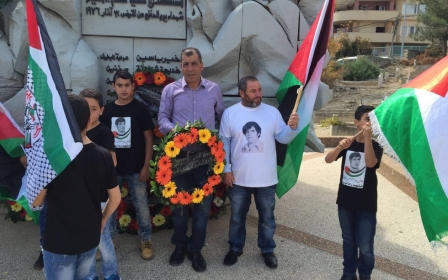70 years later: Why Palestinians are marching back home

GAZA STRIP - On a small wooden chair in front of her house in the Al-Nasr neighbourhood of northern Gaza city, sits 82-year-old Fadila al-Ashi, eager to discuss her favourite topic: the good old days and her house in Beersheba, which today is a southern Israeli town.
We woke up one day to find out that Israeli forces had stormed our neighbourhood, and they forced us to leave our homes without any prior notice
- Fadila al-Ashi, grandmother
“I am sitting here since my grandson told me you were coming to ask about my hometown. I still remember everything as if it happened yesterday,” al-Ashi told Middle East Eye. “I was born and lived in Beersheba for 12 years. My father was a small shop owner, and although we did not have much money back then, we were much happier than we are today.”
Al-Ashi was one of more than 750,000 Palestinians who were forcibly displaced from their towns and villages in the occupied Palestinian territories, in the wake of Israel's establishment in May 1948, in what Palestinians call the Nakba (the catastrophe).
“We woke up one day to find out that Israeli forces had stormed our neighbourhood, and they forced us to leave our homes without any prior notice,” said al-Ashi. “We walked for hours until we arrived in Gaza. The situation was no better there. We slept for days in a horse stable and thought we were soon returning to our villages, but that never happened.”
According to al-Ashi, the dream of return for Palestinian refugees is only a matter of time. “We had our home’s key hung on our wall for years. We asked our father to get rid of it, but he always refused and said we were soon going back home,” she recounted.
Almost 70 years later, the number of Palestinian refugees around the world is more than 5.34 million, according to the United Nations Relief and Works Agency for Palestine Refugees (UNRWA); while the Palestinian Central Bureau of Statistics (PCBC) estimates that refugees constitute 42 percent of the 4.5 million population of Palestine (the state of Israel, the occupied West Bank and Jerusalem, and Gaza).
The Great Return March
A large network of Palestinian activists - backed by Palestinian factions - is preparing for a 46-day mass march to demand their right of return. The Great Return March is scheduled to kick off on 30 March from several areas including Gaza, the West Bank and Jerusalem. The organisers have also called for protests and marches in Jordan, Syria and Lebanon.
The day coincides with what Palestinians call Land Day, to commemorate the day Israeli forces killed six Palestinians during protests against land confiscation in 1976.
We are planning for a peaceful march where we will not even throw rocks
- Ahmed Aburtema, spokesperson for The Great Return March
“We are planning for a peaceful march where we will not even throw rocks,” emphasised Ahmed Aburtema, spokesperson for the organising committee of the March in Gaza. “Even if Israeli soldiers use excessive force to disperse the demonstration, we will not stop until we cross the borders and reach our occupied villages,” he added.
The Israeli military deployed more than 100 sharpshooters on the Gaza border ahead of the planned mass demonstration, Reuters reported on Wednesday.
The protests are expected to continue until 15 May, which marks the 70th anniversary of the Nakba.
Yet according to organisers, this year's mass march is in response to recent leaks from US President Donald Trump’s "ultimate deal," which suggests the establishment of a Palestinian state consisting of Gaza and half of the West Bank, while excluding Jerusalem. The deal also compromises the Palestinian right of return. The Great March will assert the Palestinian right to self-determination, the organisers added.
We had our home’s key hung on our wall for years. We asked our father to get rid of it, but he always refused and said we were soon going back home
- Fadila al-Ashi, grandmother
“The Friday return march was supposed to happen long ago. We do not want anything from the Israelis. We just want to peacefully return back home,” al-Ashi concluded.
The march also comes as part of their continuous demands for the full implementation of the United Nations General Assembly Resolution 194 of December 1948, which stipulates that “the refugees wishing to return to their homes and live at peace with their neighbours should be permitted to do so at the earliest practicable date”.
‘We had no choice’
Halima Abudayya, 91, has lived her last 70 years dreaming of return. She is originally from Dayr Sunayd, a Palestinian village in the Gaza subdistrict that was under the British mandate when her family tragedy occurred. “I had three children and was pregnant when we were displaced. It was the hardest day of my entire life,” Abudayya recalled.
“Israeli soldiers started to arrive at our village by trucks. They were shooting everywhere. We had to sleep in my father’s agricultural land at night and return back home in the morning,” she continued. “[Later] we were forced at gun point to get in cars that drove us to a place near the borders with Gaza, where we stayed for three days, and then were moved again to the Gaza Strip.”
When asked if she still had her house keys, Abudayya spoke of how they never needed them.
“We never had a key for our home. Before the Nakba (catastrophe) took place, our village was so safe that we did not even need to lock our doors.”
A tearful Abudayya remembers her brother being shot and killed by an Israeli soldier, leaving them little choice. “It was an either die or leave situation.”
We were forced at gun point to get in cars that drove us to a place near the borders with Gaza
- Halima Abudayya
“If the activists succeed in reaching the occupied territories on Friday, the first thing they will see is my father’s 30-acre agricultural land. I hope today’s youth can do what we could not do seventy years ago.”
According to Halima, Israeli settlers have turned her father's agricultural land into a bee farm.
Dayr Sunayd was one of some 400 other villages that were destroyed and depopulated in 1948.
Israel has imposed a suffocating blockade on the Gaza Strip since 2007 after Hamas took control of Gaza from forces loyal to Palestinian President Mahmoud Abbas, one year after it won legislative elections.
In July 2017, a United Nations report revealed that the life conditions of nearly two million residents - including 1.3 million refugees - are dramatically exacerbating and the Strip has become “unlivable”.
“People in Gaza are so desperate they believe the situation would not get any worse,” said Ramy Abdu, founder and former chairman of Euro-Mediterranean Rights Monitor. “It is time that the international community regarded Palestinian refugees as humans with a political and humanitarian cause rather than just a fragile population in continuous need for relief supplies.”
Abu Hani al-Khatib, an 83-year-old barber who owns a small shop at the Feras popular market in central Gaza city, says he wishes for nothing more than returning to Karatiyya, a Palestinian village in the northeast of the Gaza Strip.
According to al-Khatib, Jaffa lost most of its Arab population because they had to flee intense attacks on their villages in the late 1940s.
Even if we, the originally displaced population, die soon, our grandsons will not settle until they revive our 70-year-old dream
- Abu Hani al-Khatib, barber
He said that Palestinians had no choice but to escape the fierce attacks on their towns and villages."We fled our homes and took nothing with us. We thought we were returning back in two or three days. It has been seventy years."
Al-Khatib laments that the international community and the United Nations have been discussing the crisis and drafting resolutions for 70 years “as if the equation was that hard”.
Palestine was under British rule from 1917 to 1948, when British forces withdrew following months of fierce fighting. In 1917, Arthur Balfour, Britain's foreign secretary at the time, promised to help establish a national home for the Jewish people in Palestine, in what is known as the Balfour declaration.
“Even if we, the originally displaced population, die soon, our grandsons will not settle until they revive our 70-year-old dream. It is that simple," al-Khatib said.
Middle East Eye propose une couverture et une analyse indépendantes et incomparables du Moyen-Orient, de l’Afrique du Nord et d’autres régions du monde. Pour en savoir plus sur la reprise de ce contenu et les frais qui s’appliquent, veuillez remplir ce formulaire [en anglais]. Pour en savoir plus sur MEE, cliquez ici [en anglais].


